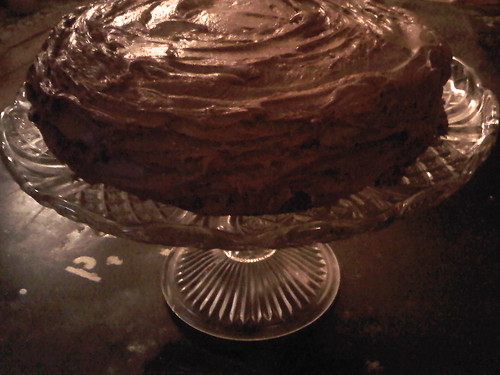Luckily Jenna agreed to overlook the fact it is technically February and allow me to submit my chocolate cake to the January Food Challenge. Without further ado then I present to you my cake: Nigella's Old Fashioned Chocolate Cake.
 {Image by the Author}
{Image by the Author}And here's how to make it:
| FOR THE CAKE: | ||||||||||||||||||||||||||||
| 200g plain flour | ||||||||||||||||||||||||||||
| 200g caster sugar | ||||||||||||||||||||||||||||
| 1 teaspoon baking powder | ||||||||||||||||||||||||||||
| 1/2 teaspoon bicarbonate of soda | ||||||||||||||||||||||||||||
| 40g best-quality cocoa | ||||||||||||||||||||||||||||
| 175g soft unsalted butter | ||||||||||||||||||||||||||||
| 2 large eggs | ||||||||||||||||||||||||||||
| 2 teaspoons real vanilla extract | ||||||||||||||||||||||||||||
| 150ml sour cream | ||||||||||||||||||||||||||||
| FOR THE ICING: | ||||||||||||||||||||||||||||
| 75g unsalted butter | ||||||||||||||||||||||||||||
| 175g best quality dark chocolate, broken into small pieces | ||||||||||||||||||||||||||||
| 300g icing sugar | ||||||||||||||||||||||||||||
| 1 tablespoon golden syrup | ||||||||||||||||||||||||||||
| 125ml sour cream | ||||||||||||||||||||||||||||
| 1 teaspoon real vanilla extract METHOD {My additions to the recipe}
| ||||||||||||||||||||||||||||
PS. American readers - if you need any explanations of ingredients or weights/measures please leave me a comment and I shall endeavour to find the translation. |

No comments:
Post a Comment